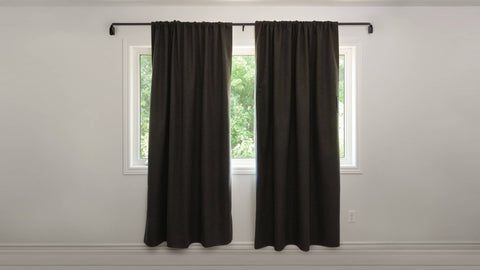Understanding Sound Transmission: Factors Affecting Noise Penetration through Windows
To evaluate the effectiveness of blackout curtains in reducing noise, it's first necessary to understand how sound transmission works. Sound travels in waves, and when these waves hit a barrier, like a window, they cause the barrier to vibrate, transmitting the sound through it. Several factors can affect this process, including the thickness and density of the barrier, the frequency of the sound waves, and any gaps in the barrier where sound can leak through. In the context of windows, single-pane windows allow more noise to penetrate than double-pane ones, and gaps around the window frame can also contribute significantly to noise transmission.
The Role of Blackout Curtains in Noise Reduction: Exploring the Design and Materials
Blackout curtains, with their typically thick and dense construction, can help reduce the amount of noise entering a room. The heavy, often multi-layered fabric helps to absorb and dampen sound waves, reducing their intensity. Some blackout curtains are specifically designed for noise reduction and feature additional layers of sound-absorbing material. However, it's important to note that while blackout curtains can contribute to a quieter room, they are not typically designed primarily for soundproofing.
Soundproofing vs. Noise Reduction: Managing Expectations with Blackout Curtains
When discussing noise control, it's essential to differentiate between soundproofing and noise reduction. Soundproofing aims to completely block sound transmission, which typically requires specialized construction techniques and materials. Noise reduction, on the other hand, involves lessening the intensity of sound to make it less intrusive. Blackout curtains fall into the latter category. While they can help dampen noise and create a quieter environment, they won't completely block out all outside noise.
Complementary Strategies: Combining Blackout Curtains with Other Soundproofing Techniques
For the best results in reducing noise, consider combining blackout curtains with other soundproofing techniques. These could include installing double-glazed windows, sealing gaps around windows and doors with weatherstripping, and using other sound-absorbing materials in the room, such as rugs, carpets, and upholstered furniture. The combined effect of these measures can create a significantly quieter living environment.
Best Curtains for Noise Reduction
If reducing noise is a priority for you, look for blackout curtains that are specifically designed with this purpose in mind. These curtains will have additional layers of dense, sound-absorbing material and will be marketed as noise-reducing or sound-dampening.
In conclusion, while blackout curtains can help reduce noise to some extent, it's important to manage your expectations and consider additional soundproofing measures for the best results.
Happy Sleeping!
Combining blackout curtains with techniques like sealing gaps and using sound-absorbing materials can create a more peaceful and quieter living environment. If noise reduction is a priority for you, consider investing in blackout curtains specifically designed for this purpose.
Consider investing in the most recommended blackout curtain by sleep specialists in North America. Use the code WELCOME10 for $10 off and start your journey towards a quieter and more serene home.







